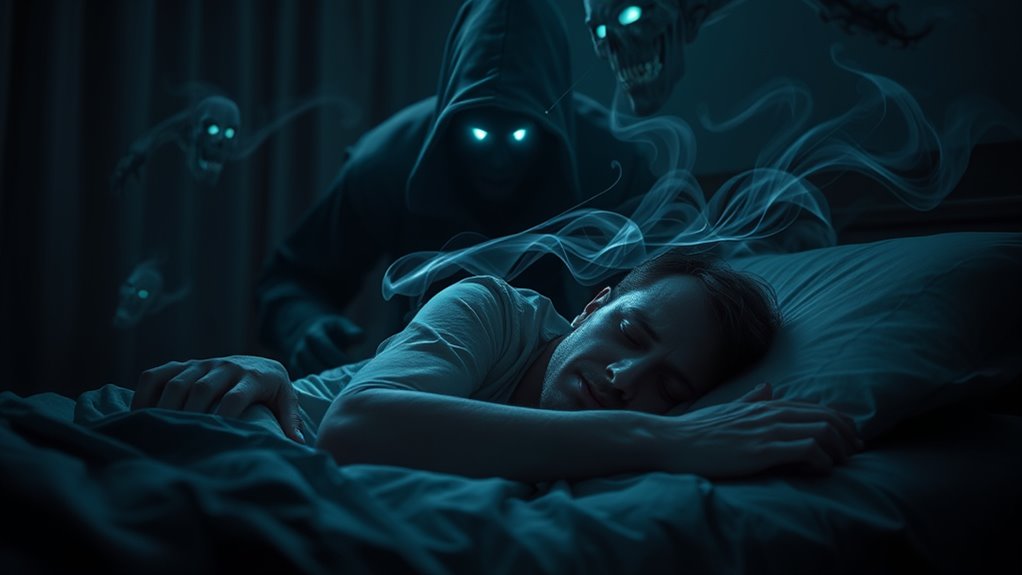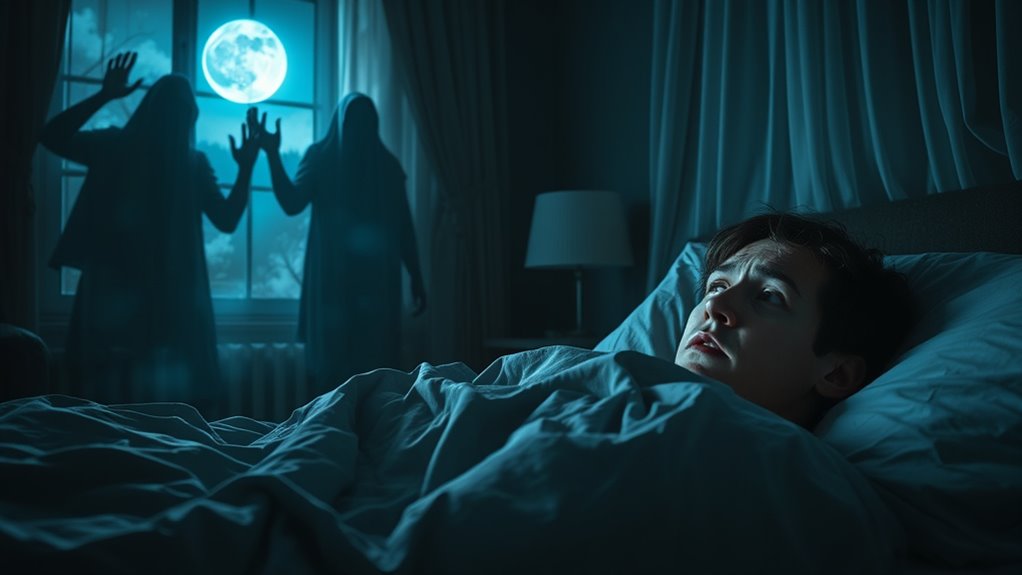Sleep paralysis visions happen when you’re partially aware and unable to move, experiencing vivid, often surreal hallucinations that blur the line between dreams and reality. Unlike regular nightmares, which fully immerse you in distressing stories or images during sleep, these visions may include shadowy figures or strange scenes but often come with recognition that they’re hallucinations. Understanding these differences can help you better manage your experiences—keep going to uncover more insights.
Key Takeaways
- Sleep paralysis visions occur during partial wakefulness with awareness of surroundings, unlike nightmares where full sleep immersion occurs.
- Visions are often surreal, disconnected images or entities, whereas nightmares follow a narrative involving personal fears or trauma.
- During sleep paralysis, individuals recognize hallucinations as unreal, while nightmares typically lack this awareness and evoke full emotional distress.
- Hallucinations in sleep paralysis may include shadowy figures or surreal scenes, differing from the realistic, story-driven content of nightmares.
- Recognizing sleep paralysis as a REM sleep phenomenon can reduce fear, whereas nightmares often cause distress without awareness of their unreal nature.

Sleep paralysis visions can be deeply unsettling experiences that occur when you’re caught between wakefulness and REM sleep. During these episodes, your mind is partially conscious, yet your body remains immobilized, leading to vivid and often frightening visual or auditory hallucination experiences. These visions can feel incredibly real, making it easy to mistake them for actual threats or encounters. Unlike regular nightmares, which typically happen during sleep and involve distressing stories or images, sleep paralysis visions happen while you’re aware of your surroundings, even if your body is paralyzed. This unique state blurs the line between dreaming and waking, heightening the intensity of these hallucination experiences.
Sleep paralysis visions are vivid, frightening hallucinations occurring between wakefulness and REM sleep.
One key difference that sets sleep paralysis visions apart from nightmares is the element of consciousness. In a nightmare, you usually lose awareness of reality, becoming fully immersed in the story or images your subconscious creates. With sleep paralysis visions, you’re often aware that you’re experiencing something unusual but can’t move or speak. This awareness can make the hallucination feel more immediate and terrifying. Many people find themselves experiencing a form of lucid dreaming during these episodes, where they recognize the dream-like nature of the visions but feel powerless to wake themselves or alter what’s happening. This unique state often amplifies feelings of helplessness and fear, especially if the hallucinations involve shadowy figures or oppressive presences.
Another distinction lies in the content and emotional tone. Nightmares tend to revolve around personal fears, traumatic memories, or vivid scenarios that evoke strong emotions like terror or sadness. Sleep paralysis visions, on the other hand, often involve inexplicable sights or sounds that don’t necessarily follow a narrative but still evoke intense fear or awe. Because these visions are hallucination experiences generated by your brain during a disrupted sleep cycle, they can sometimes include bizarre or surreal images that seem disconnected from your waking life. Some people report seeing shadowy entities, feeling a heavy weight pressing down on their chest, or sensing a presence in the room—all of which are hallucinatory by nature. Additionally, understanding sleep paralysis visions as a result of REM sleep phenomena can help diminish their power over you.
Frequently Asked Questions
Can Sleep Paralysis Visions Be Considered Hallucinations?
You might wonder if sleep paralysis visions qualify as hallucinations. During sleep paralysis, your subjective perception often involves sensory distortion, making you experience vivid images or sensations that seem real. These visions are considered hallucinations because they are false sensory perceptions that occur without an external stimulus. So, yes, sleep paralysis visions are a form of hallucination, driven by your brain’s altered state and sensory processing during these episodes.
Are Sleep Paralysis Visions Always Frightening or Disturbing?
You might wonder if sleep paralysis visions are always frightening. While many experience fear factors during these episodes, they aren’t necessarily always disturbing. Unlike nightmare distinctions, some visions are neutral or even comforting. Your reaction depends on individual factors and context. Remember, not every sleep paralysis vision involves fear, but it’s common for people to find them unsettling due to their vivid, dream-like qualities and the sudden, involuntary nature of the experience.
How Long Do Sleep Paralysis Visions Typically Last?
You might wonder how long sleep paralysis visions last. Usually, their visual duration spans a few seconds to a couple of minutes, depending on your sleep cycle. During an episode, your brain remains semi-aware, so the visions feel intense but are brief. Factors like stress or sleep deprivation can influence this duration, but generally, they resolve quickly as you shift through different stages of your sleep cycle.
Do Sleep Paralysis Visions Occur During REM Sleep?
Did you know that nearly 8% of people experience sleep paralysis at some point? During these episodes, your visions usually occur during REM sleep, when your body’s naturally paralyzed to prevent acting out dreams. Sleep paralysis visions happen as you shift between sleep cycles, especially from REM to wakefulness. Unlike lucid dreaming, where you’re aware you’re dreaming, these visions are involuntary and often frightening, linked directly to REM sleep disruptions.
Can Sleep Paralysis Visions Happen to Anyone Regardless of Health?
You might wonder if sleep paralysis visions can happen to anyone, regardless of health. The answer is yes; these visions can occur in anyone experiencing a sleep disorder or mental health issues. Stress, anxiety, or irregular sleep patterns increase your risk, but they’re not exclusive to those with diagnosed conditions. Sleep paralysis is a common phenomenon, and understanding its links to sleep and mental health helps you manage or prevent episodes.
Conclusion
While sleep paralysis visions can be frightening, remember they’re just vivid hallucinations caused by your brain’s temporary shutdown. It’s easy to think they mean something supernatural, but understanding the science helps you feel more in control. Next time you experience them, remind yourself it’s just your mind’s way of processing fear and stress. With awareness and calm, you can reduce the intensity and even prevent future episodes. You’ve got this—knowledge is your best tool.











